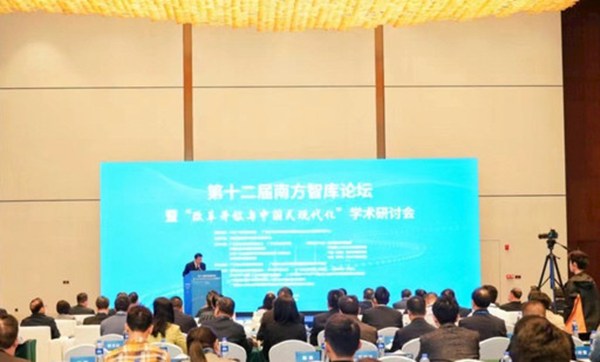


Seminar probes opening up and Chinese modernization

A forum on reform and opening up in Zhuhai, Guangdong Province, on Dec. 7 Photo: Li Yongjie/CSST
ZHUHAI—The 12th Southern Think Tank Forum under the theme of “Reform and Opening up and Chinese Modernization” took place in Zhuhai, Guangdong Province, on December 7.
New round of reform
“Socialism with Chinese characteristics is vigorous in that it is socialism that carries out reform and opening up,” said Li Junru, executive vice chairman of the China Institute for Innovation and Development Strategy. In the new era, we must steadfastly advance reform and opening up under the guidance of General Secretary of the Communist Party of China (CPC) Central Committee Xi Jinping. It is necessary to adhere to domestic circulation as the mainstay, striving to achieve high-quality development under the new development pattern. Meanwhile, efforts are required to foster innovation in institutional opening up and promote high-standard opening up through domestic and international circulations that mutually reinforce each other.
“The new round of reform must focus on market-oriented reform of factors of production,” said Peng Sen, president of the China Society of Economic Reform. Looking back, reform and opening up constituted the “key move” that determined China’s contemporary development. Looking ahead, China’s reform, especially market-oriented reform, will continue to be a “key move” to forge ahead, driving the country’s economic recovery and stable growth.
Liu Wei, former president of Renmin University of China, proposed establishing a new pattern of comprehensive, high-quality, and dynamic opening up through goal reorientation, mechanism adjustment, path reconstruction, and form evolution. Specifically, goals should shift from a comparative advantage to a new competitive advantage orientation. Mechanisms should shift from “putting both ends of the production process (the supply of raw materials and the marketing of products) on the world market” and “massive import and export” to “driving external development with internal forces and “optimized import and export.” Path reconstruction should change from industrial path dependence to industrial collaborative innovation, and forms should evolve from policy-based opening up to institutional opening up.
Chinese modernization
According to Zheng Yongnian, chairman of the academic committee of the Institute of Public Policy at South China University of Technology, Chinese modernization is comprehensive, integrated, and multi-dimensional. Its connotation can be understood at three levels: material, humanistic, and institutional modernization. Advancing Chinese modernization on this new journey requires leveraging the three “magic weapons” of reform, opening up, and innovation, with opening up being the most important and serving as the basis or prerequisite for the other two.
In the view of Huang Qunhui, director and a research fellow from the Institute of Economics at the Chinese Academy of Social Sciences (CASS), new type of industrialization and Chinese modernization are inherently consistent. New industrialization aligns with Chinese modernization in terms of the transformation and upgrading of the manufacturing industry towards high-end, digital, green, and service-oriented development. Enhancing the quality of supply in the real economy lays a solid foundation for Chinese modernization.
Paradigm of Guangdong
Guo Yuewen, secretary of the Leading Party Members’ Group of the Guangdong Academy of Social Sciences (GDASS), explained that Chinese modernization is socialist modernization led by the CPC, representing a significant innovation in the theory and practice of global modernization.
The smooth and steady progress of Chinese modernization justifies its identity as the only correct road towards building a strong country and rejuvenating the nation. The practices in Guangdong Province have fully demonstrated that reform and opening up is a bright path to stimulate the dynamism and vitality of Chinese modernization, expanding its development space.
New drivers of economic and trade cooperation between Guangdong and ASEAN have continued to emerge in recent years. Chi Fulin, president of the China Institute for Reform and Development, believes that Guangdong is well-positioned to develop new advantages in achieving high-level openness with ASEAN, and serves as the new frontier of high-level opening up to ASEAN in China.
Shenzhen City has been entrusted with the significant mission of building a pilot demonstration zone of socialism with Chinese characteristics. Guo Wanda, executive vice president of the China Development Institute, stated that, to align with other advanced cities around the world, Shenzhen still needs to further deepen high-level international scientific and technological cooperation, build cross-regional strategic industrial clusters, and construct a new pattern of regional cooperation. The city is tasked with leading the forefront of Chinese modernization featuring high-quality development.
Entrepreneurial and industrial innovation represent typical strengths of the Pearl River Delta, concluded Chen Xian, a professor from the Antai College of Economics and Management at Shanghai Jiao Tong University. The culture of innovation in Shenzhen and the Pearl River Delta breeds generations of entrepreneurs and nurtures the entrepreneurial spirit. The delta’s industrial innovation advantages have spurred scientific and technological development, and are expected to continue to serve as a paradigm on the new journey.
The forum was hosted by Guangdong Social Sciences Association, GDASS, the Institute of Economics at CASS, the working committee of Guangdong-Macao In-Depth Cooperation Zone in Hengqin of the CPC Guangdong Provincial Committee, and the Publicity Department of the CPC Zhuhai Municipal Committee.
Editor:Yu Hui
Copyright©2023 CSSN All Rights Reserved